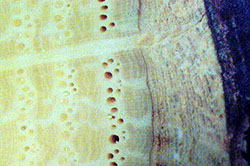Home > Tree structure basics > How trees grow
How trees grow

Trees use the sun, carbon dioxide, water, and minerals to produced sugars, also known as tree food. This is a fairly simple process that occurs in a complicated organism. Water entering roots moves to the canopy through the xylem.
Xylem makes up the woody part of the tree that begins on the inside of the cambium. It extends through to the pith or the trunk center. Xylem is made up of living and non-living cells in roots, trunk, branches and foliage. It can be thought of as a pipeline from roots to leaves.
In dicot plants, a new layer of xylem is produced by the secondary growth system, the cambium, each year (or several times each year in some tropical trees) forming a new growth ring in trunks and branches. Xylem in foliage is produced by primary growing points in buds.
As water evaporates from the foliage (this process is called transpiration) through openings in leaves called stomata, it pulls adjoining water molecules with it. This pulling action helps draw water up the trunk and into the leaves. In addition, some trees may be capable of exerting a pumping action to push water up the tree.
Most water moves up through the apoplast or the network of open, dead conducting elements in xylem. Elements (also called nutrients) such as nitrogen and potassium move from the soil up to the foliage in the xylem cell sap.
Photosynthesis in foliage, twigs and other green plant parts produces sugars (and other components) that are used by the tree to carry out its many functions. Sugars are moved about the plant in a layer of cells called the phloem. Phloem is made up of living cells located just outside the cambium. The cambium produces the phloem in trunks, branches and roots. The tree usually expends energy moving sugars, growth regulators, proteins and essential elements up and down the phloem to other locations in the plant.
Once sugar arrives at a location, it is used to carry out normal processes or it is stored. It is stored as starch in the network of living cell contents called the symplast. Starch is a chain of sugars linked together. Starch is considered the money, or the energy, in the tree bank. The bank is the living xylem or wood in branches, stems, trunk, and roots. If there is less stored starch, there is less stored energy in the bank. Trees need stored starch to carry on normal functions, especially to break dormancy in temperate trees.
Rays are long groups or plates of living cells that extend from the phloem into the xylem toward the center of the trunk. On their way to the xylem, they cross the cambium. They extend several inches or more up and down the trunks, branches and roots. Sugars move from the phloem into the energy bank (xylem) through the rays. On healthy trees, rays are rich in starch.
Improper pruning such as topping, cutting roots, flush cutting, and injuring the trunk and main branches can make the energy bank considerably smaller. If the bank is made smaller, less energy can be stored. This makes the tree more susceptible to attack by agents such as insects and disease. Improper pruning can also make it tough for trees to recover from floods, droughts, or other stresses.

